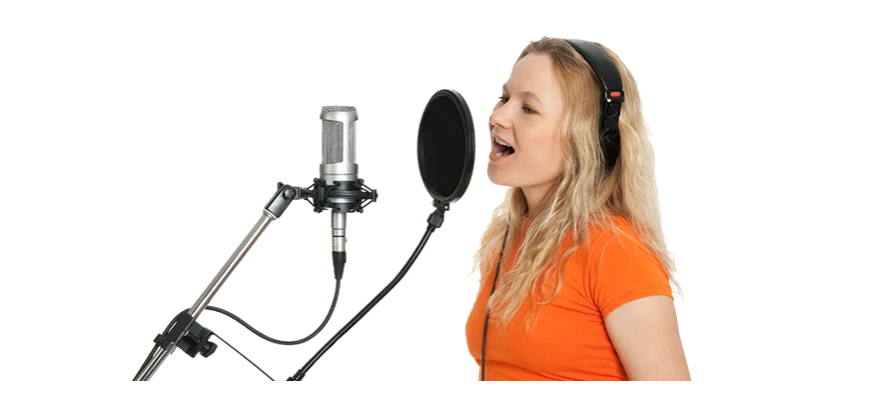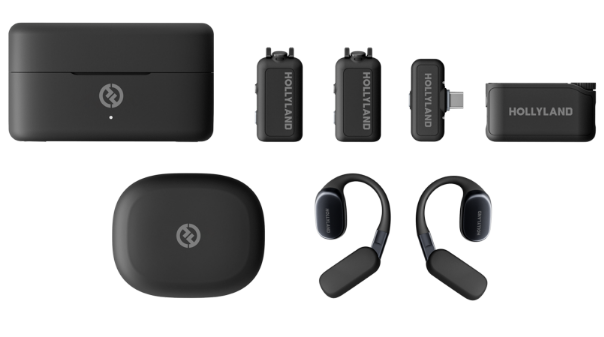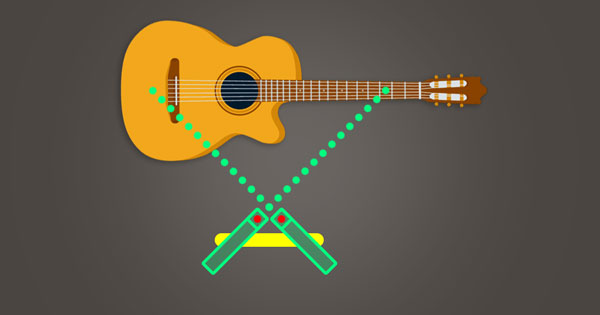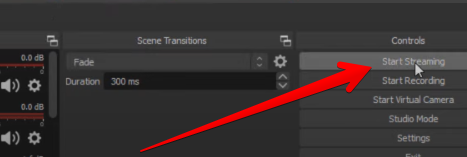Are you looking to capture the rich, authentic sound of your acoustic guitar? Whether you’re laying down tracks in a studio or setting up a home recording space, finding the perfect microphone is key. It’s not just about recording sound—it’s about preserving the nuances of your instrument’s tone and resonance. With countless options on the market, choosing the right mic can feel overwhelming. That’s why we’ve put together a list of the best microphones specifically designed to do your acoustic guitar justice. Prepare to bring out the true voice of your guitar and take your recordings to the next level.
When looking for the best acoustic guitar microphone for recording, consider the following key criteria to ensure you capture the guitar’s natural tone with the utmost clarity and definition:
- Polar Pattern – Microphones with cardioid or supercardioid patterns are ideal for minimizing room noise and isolating the guitar’s sound. Omnidirectional mics can also be used for a more natural ambient sound if the recording environment is controlled.
- Frequency Response – Ensure the microphone has a wide and flat frequency response that can accurately capture the rich spectrum of your acoustic guitar, from the deep lows to the shimmering highs without any unwanted coloration.
- Sensitivity – A highly sensitive microphone will pick up the nuances and subtleties of your guitar playing, which is crucial for high-quality acoustic recordings.
- Durability and Build Quality – Look for a sturdy microphone that can withstand the occasional accidental bump or knock, especially if you plan on recording outside a studio environment.
- Ease of Use and Placement – Consider how easily the microphone can be positioned in relation to your guitar. Clip-on mics or small diaphragm condensers can be easier to position precisely.
- Compatibility – The microphone should be compatible with other recording equipment you plan to use, including stands, cables, and audio interfaces.
Selecting a microphone based on these criteria will help you find an option that delivers the best performance for your acoustic guitar recordings.
| Microphone | Type | Polar Pattern | Frequency Response | Sensitivity (approx.) | Accessories Included | Price Range (approx.) |
|---|---|---|---|---|---|---|
| Shure SM81-LC | Small Diaphragm Condenser | Cardioid | 20 Hz – 20 kHz | -10 dBV/Pa | Swivel Adapter, Windscreen, Carrying Case | $350 – $400 |
| Rode NT5 | Small Diaphragm Condenser | Cardioid | 20 Hz – 20 kHz | -19 dBV/Pa | Stand Mount, Windshield | $200 – $250 (each) |
| AKG Pro Audio C214 | Large Diaphragm Condenser | Cardioid | 20 Hz – 20 kHz | -34 dBV/Pa | Shock Mount, Metal Carrying Case, Windscreen | $350 – $450 |
| Audio-Technica AT4041 | Small Diaphragm Condenser | Cardioid | 20 Hz – 20 kHz | -36 dBV/Pa | Stand Mount, Windscreen, Protective Carrying Case | $250 – $300 |
| Neumann KM 184 | Small Diaphragm Condenser | Cardioid | 20 Hz – 20 kHz | -39 dBV/Pa | Windscreen, Clamp for Microphone Stand | $800 – $900 (each) |
Remember to check whether each microphone requires additional equipment such as a microphone stand, pop filter, or an audio interface with phantom power (usually required for condenser microphones) for optimal use, as these could affect the overall budget for your recording setup.
Shure SM81-LC Cardioid Condenser Instrument Microphone

Overview:
The Shure SM81-LC is a revered staple in the world of acoustic guitar recording—a microphone that has stood the test of time, known for its durability, precision, and consistent performance. I’ve had the opportunity to use this mic in various settings and am continually impressed by its crisp, clear capture of acoustic string instruments. It has a smooth response and can handle both the subtle nuances and the dynamic range with equal aplomb.
What stands out most with the SM81 is its ability to provide a natural acoustic sound. There’s no coloration or hyped frequencies, which means what you play is what you get. The cardioid pattern effectively isolates the guitar from other sound sources, making it ideal for both studio and live environments. It’s particularly well-suited for micing up acoustic guitars due to its tailored frequency response and detail.
Specs:
- Polar Pattern: Cardioid
- Frequency Response: 20Hz to 20kHz
- Phantom Power Requirements: 11 to 52 V
- Output Impedance: 150 ohms
- Sensitivity: -45 dBV/Pa (5.6 mV)
- Maximum SPL: 136 dB
Pros & Cons:
Pros:
- Exceptional flat frequency response, ensuring true acoustic sound
- High SPL handling capabilities for versatility with louder instruments/sources
- Low self-noise, allowing for clean recording without intrusive hiss
- Rugged construction – It’s a microphone that can last decades with proper care
- The three-position low-frequency switch offers flexibility to tailor the mic to the recording space or guitar’s characteristics
Cons:
- Relatively high price tag compared to some entry-level alternatives
- Requires phantom power, which might be a slight inconvenience for mobile or simplistic setups
- Included accessories are basic – might need an additional investment in mounts or windscreens for specific uses
Price:
The Shure SM81-LC is often found in the higher price bracket, usually sitting anywhere between $300 to $400. Considering its professional-level performance and long-term reliability, I see it as a sound investment for serious musicians and audio engineers alike.
In summary, the Shure SM81-LC is a microphone that’s hard to fault. Whether you are a burgeoning recording artist, a touring musician, or an engineer in search of a reliable tool for your studio arsenal, it offers a blend of quality and ruggedness that is hard to beat. It’s an investment into your sound, arguably as important as your choice of guitar, and one that will pay off in the richness of your recordings.
Rode NT5 Compact Cardioid Condenser Microphone
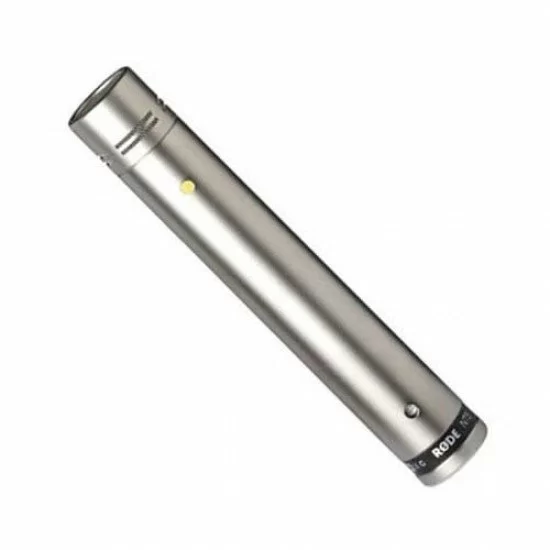
Brief Intro:
The Rode NT5 is a well-recognized microphone in the world of studio and stage recordings. Revered for its versatility, it is a favorite among musicians and audio engineers alike. With its compact design, the NT5 is particularly suited for miking acoustic guitars, where capturing the natural resonance and tone of the instrument is critical.
Overview:
In my experience, the Rode NT5 stands out for its detail and clarity. It offers a true-to-source sound that is essential for an acoustic guitar, providing a bright, but not harsh capture of the instrument. This microphone feels at home in both a live setting and a studio environment. Its cardioid pickup pattern does an excellent job at isolating sound, which means it focuses on the guitar while minimizing room noise and reverberations — a must-have feature for clean, professional recordings.
One distinguishing aspect of the NT5 is its ability to handle high sound pressure levels with ease. When recording more dynamic guitar playing or even other instruments like violin or piano, the NT5 holds its own without distorting the sound. Also, its small size can be deceptively rugged. It feels durable and well built, which gives a sense of reliability needed in a studio mic.
Specs:
- Acoustic Principle: Externally polarized single diaphragm condenser
- Active Electronics: JFET impedance converter with bipolar output buffer
- Capsule: 0.5″
- Polar Pattern: Cardioid
- Frequency Range: 20 Hz – 20 kHz
- Output Impedance: 100Ω
- Maximum SPL: 143 dB SPL (@ 1kHz, 1% THD into 1KΩ load)
- Sensitivity: -38 dB re 1 Volt/Pascal (12 mV @ 94 dB SPL) +/- 2 dB @ 1kHz
Pros:
- Exceptional clarity and detail in sound capture
- Compact and durable design makes it convenient for various settings
- Good isolation with its cardioid pickup pattern, reducing background noise
- Can handle high-pressure levels without distortion
Cons:
- It might be considered a bit bright-sounding, which can be an issue for some warmer sounding instruments
- Doesn’t come with an extensive accessory package, which might necessitate additional purchases
Price:
The Rode NT5 sits at a mid-range price point, usually found around $200 – $250 per microphone. Considering its professional-quality sound capture, it’s a reasonable investment for serious musicians or sound engineers looking for an accurate acoustic mic without breaking the bank.
AKG Pro Audio C214 Professional Large-Diaphragm Condenser Microphone

Overview:
The AKG Pro Audio C214 is a professional-grade large-diaphragm condenser microphone that captures sound with a level of depth and detail that few others in its class can match. Designed as a cost-effective alternative to the revered C414, it inherits its sibling’s sonic character, with just a single-diaphragm and fixed cardioid pattern. From my experience, the C214 offers superb performance that far exceeds what its price tag might suggest.
The build quality is impressive, robust and ready for both studio and challenging outdoor settings. Tonally, it excels with acoustic guitars, delivering a warm, clear sound that’s rich in harmonic detail. Whether used for fingerpicking or hard strumming, it maintains a balanced response without the harshness that sometimes plagues recordings from lesser microphones.
Specs:
- Polar Pattern: Cardioid
- Frequency Response: 20Hz to 20kHz
- Sensitivity: 20 mV/Pa
- Equivalent Noise Level: 13 dB-A
- Dynamic Range: 143 dB
Pros & Cons:
Pros:
- The sound quality is exceptional, providing a detailed and natural reproduction of the acoustic guitar.
- It has a high-pass filter and attenuation pad, offering flexibility to record loud sources and manage low-end rumble.
- The microphone’s build is solid, reassuring its durability for both studio and field use.
- It captures low frequencies impressively well, which often is a challenge for mics in a similar price range.
Cons:
- Being a large-diaphragm microphone, it’s larger and heavier than small diaphragm mics, which may not be as easy to position perfectly.
- It lacks the multiple polar patterns and the slight edge in refinement that its big brother, the C414, boasts.
Price:
While I don’t want to quote a specific price as it can vary depending on the retailer and current promotions, the AKG Pro Audio C214 is generally considered an excellent value for the quality it provides. It sits in the mid-range price bracket for professional microphones and offers features that might be considered premium in this category. You can expect to pay less than you would for the flagship C414, making it a superb investment for serious musicians and engineers on a budget.
In conclusion, the AKG Pro Audio C214 is a robust and reliable microphone suited brilliantly for acoustic guitar recordings. It punches well above its weight class in terms of sound quality, and although it might miss some of the bells and whistles of its pricier kin, for most musicians and home studio owners, this microphone more than meets the challenge. It exemplifies a rare blend of quality and affordability and should be a top consideration for anyone looking to capture their acoustic guitar with richness and fidelity.
Audio-Technica AT4041 Cardioid Condenser Microphone

Overview:
The Audio-Technica AT4041 is a sleek, pencil-style condenser microphone that packs a punch when it comes to capturing the true essence of an acoustic guitar. Aired with its smooth frequency response and robust design, this mic is a versatile tool for musicians and engineers who are seeking to produce professional-level recordings without dealing with overly complex setups. My experience with the AT4041 has been nothing short of impressive. It tends to deliver a crisp, clear sound that really brings out the subtle nuances of an acoustic guitar.
Specs:
- Microphone Type:Condenser
- Polar Pattern:Cardioid
- Frequency Response:20Hz-20kHz
- Max SPL:145dB
- Output Impedance:100 ohms
- Signal to Noise Ratio:70dB
- Low Cut Filter:80Hz (-12dB/octave)
- Connector:XLR
- Weight:0.26 lbs.
- Manufacturer Part Number:AT4041
Pros
- Very sensitive.
- Detailed, accurate response.
- Tolerant of high SPLs.
Cons
- May be too truthful for comfort in some applications.
Neumann KM 184 Small Diaphragm Condenser Microphone
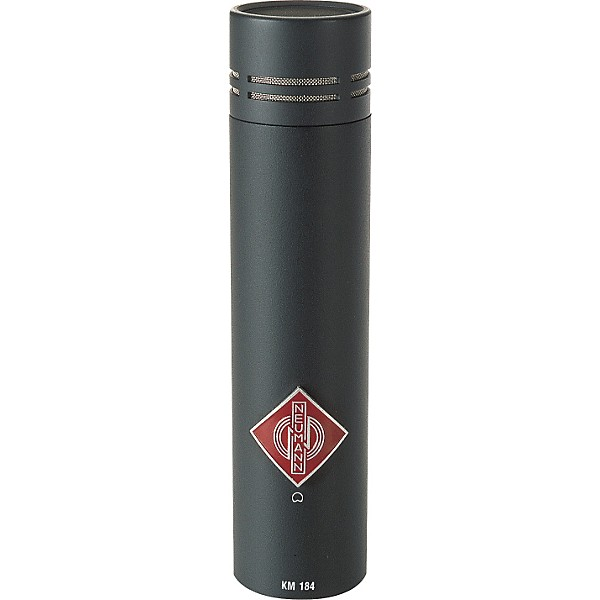
Brief Intro:
The Neumann KM 184 is a high-end small diaphragm condenser microphone that boasts exceptional sound quality. It’s a popular choice among acoustic guitarists for its ability to capture the natural resonance and detail of the instrument.
Overview:
From my experience with the Neumann KM 184, it’s clear that this microphone is a standout choice for acoustic guitar recording. It features a very smooth frequency response, which means it captures all the delicate nuances of your guitar playing with exceptional clarity. The KM 184 houses a transformerless circuitry, which provides high levels of output and low self-noise. This makes it not only a great choice for studio settings but also incredibly versatile for home studios where you might be dealing with less-than-ideal recording environments.
One of the aspects I love about the KM 184 is its capacity to handle high sound pressure levels; you can confidently use this mic up close on louder instruments without any harshness or distortion, which can be a concern with some condenser mics. It delivers a natural sound, with a slightly elevated presence in the upper midrange that helps acoustic guitars to sit perfectly in the mix without extensive post-processing.
Specs:
- Polar Pattern: Cardioid
- Frequency Response: 20Hz to 20kHz
- Sensitivity: 15 mV/Pa
- Equivalent Noise Level: 13 dB-A
- Maximum SPL: 138 dB
- Output Impedance: 50 ohms
Pros & Cons:
Pros:
- Exceptional sound clarity and natural tone capture.
- Robust construction suitable for studio and stage use.
- Remarkably flat frequency response with a gentle presence boost.
- Transformerless design for clean, unhyped recordings.
- Handles high SPLs with ease, reducing distortion on loud sources.
Cons:
- High-end price point may not be suitable for all budgets.
- Requires high-quality preamps to reach its full potential.
Price:
As a premium microphone, the Neumann KM 184 sits at the higher end of the price scale for small diaphragm condensers, often exceeding $800. However, the investment is mirrored in the quality and fidelity of recordings produced by this microphone. Enthusiasts of high-quality sound and professionals will find the price justified, whilst hobbyists or those on a tighter budget might consider it a rather aspirational item.
Conclusion:
Choosing the ideal acoustic guitar microphone for recording hinges on matching your specific needs with the right features. Whether it’s capturing the warmth and fullness of your acoustic’s sound or ensuring your recordings are crisp and free from interference, the right microphone can elevate your music significantly. Remember to consider factors such as microphone type, polar patterns, and frequency response when making your choice. Quality recordings require not just talent, but also the right tools, so invest wisely to ensure your music truly resonates with your audience.
Looking for added flexibility and exceptional clarity when recording acoustic guitar? A wireless lavalier microphone is an excellent, versatile option – allowing freedom of movement while capturing warm, natural acoustic tones.
Best Seller
Sale
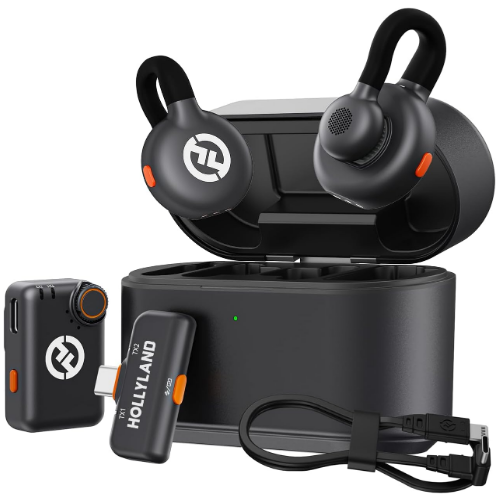
Hollyland LARK M2S – Wireless Clip-on Microphone
- 7g Lightweight, Titanium Clip, Discreet Design
- Clear sound with 24-bit/48kHz, 70dB SNR, 116dB SPL
- Noise Cancellation & 300m Long-Range Stability
- Works with Camera/iPhone/Android/Laptop
- Perfect for Content Creators, Online-Teaching, Streaming
$139
$159
FAQs:
- What type of microphone is best for recording acoustic guitars?
The most commonly recommended type of microphone for recording acoustic guitars is a small diaphragm condenser microphone due to its ability to capture detailed sound and a wide frequency range. - Do I need a microphone with multiple polar patterns for recording acoustic guitar?
While not essential, a microphone with switchable polar patterns offers versatility. A cardioid pattern often works well for single-instrument recording, but having the option to switch to omni or figure-8 can be beneficial for capturing room ambience or recording in a live setting. - How important is the frequency response of a microphone for recording guitars?
It’s quite important; the microphone should have a flat or gently tailored frequency response that accurately captures the true sound of an acoustic guitar. Look for a mic that emphasizes the clear highs and warm lows without losing the midrange.
































.png)



